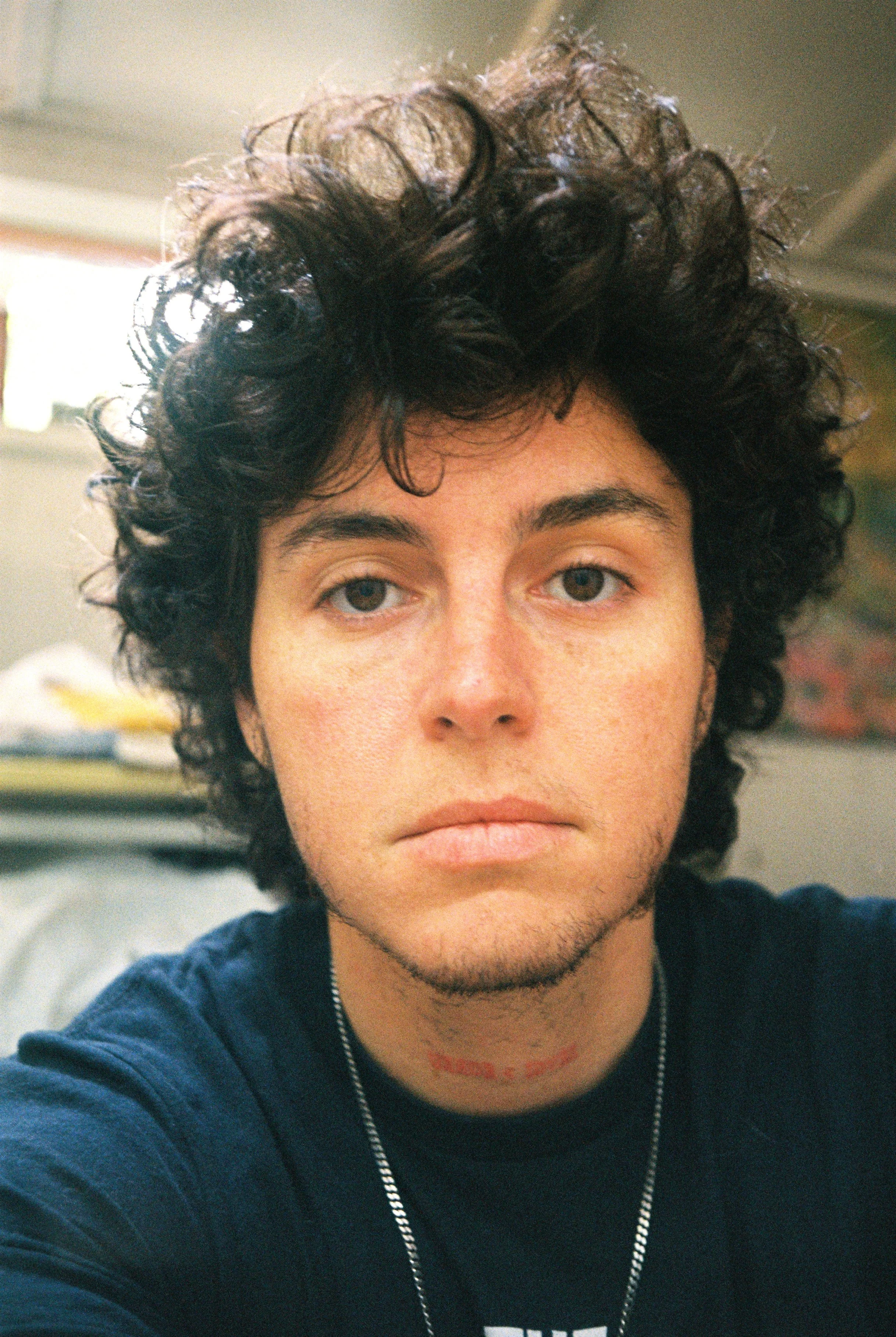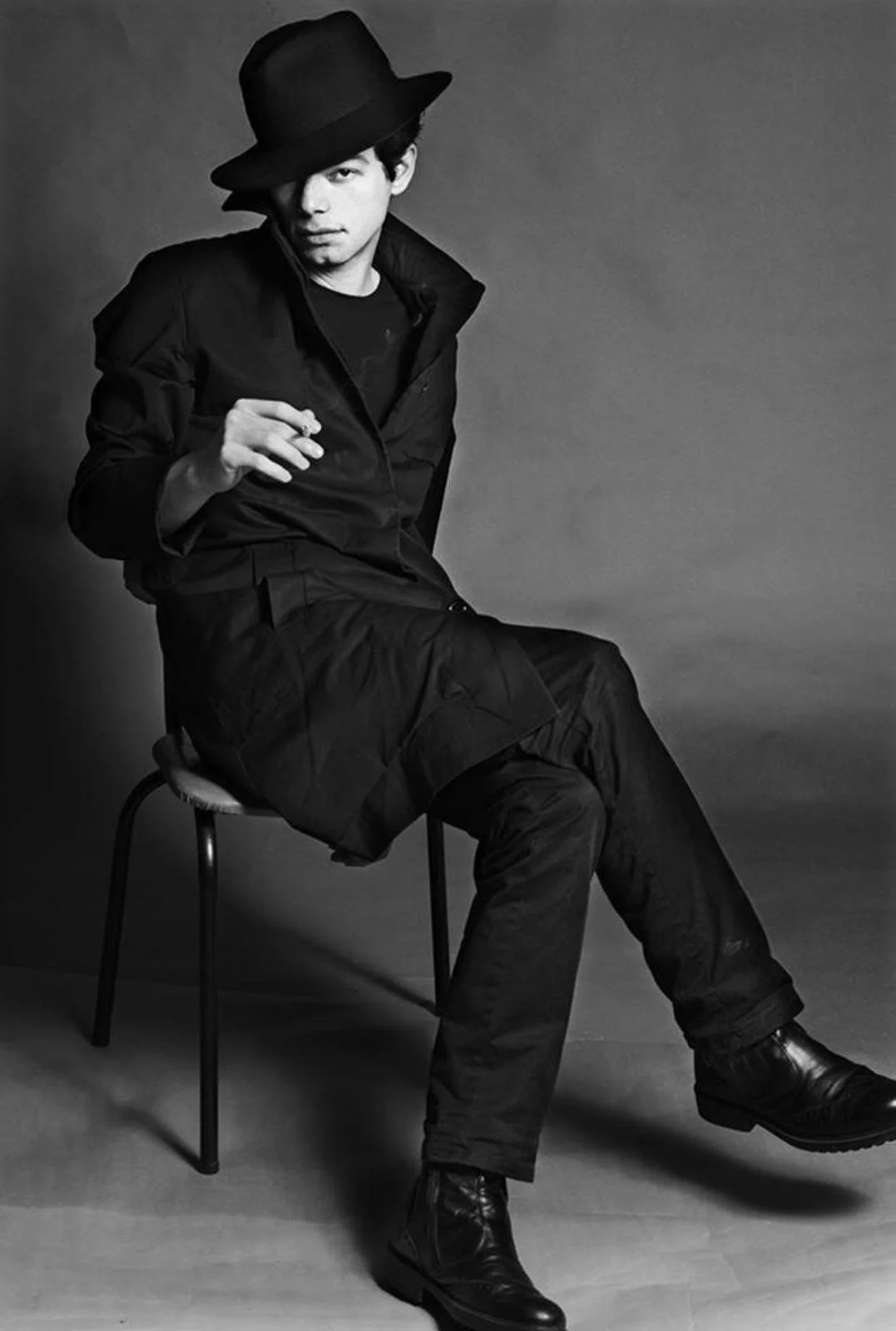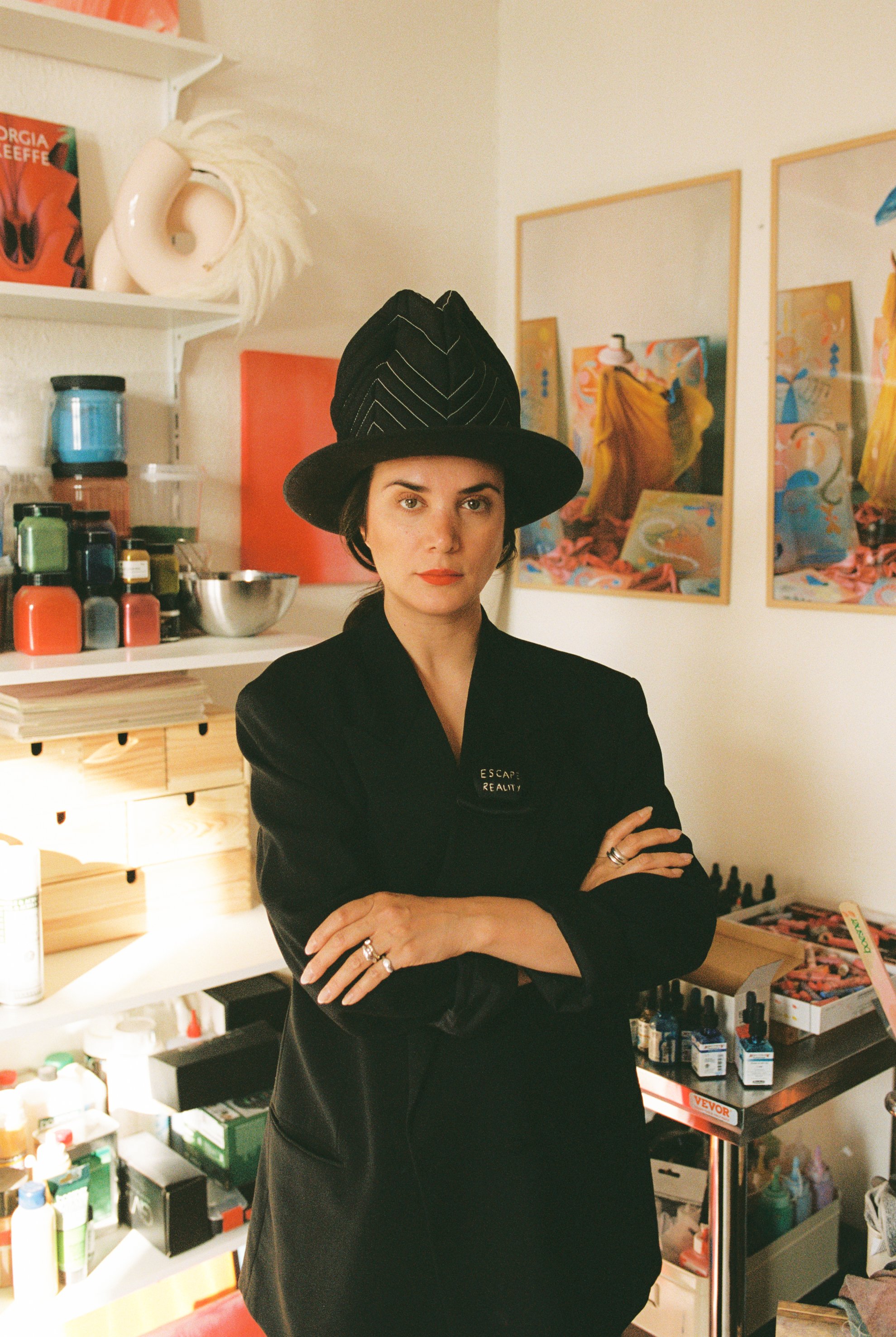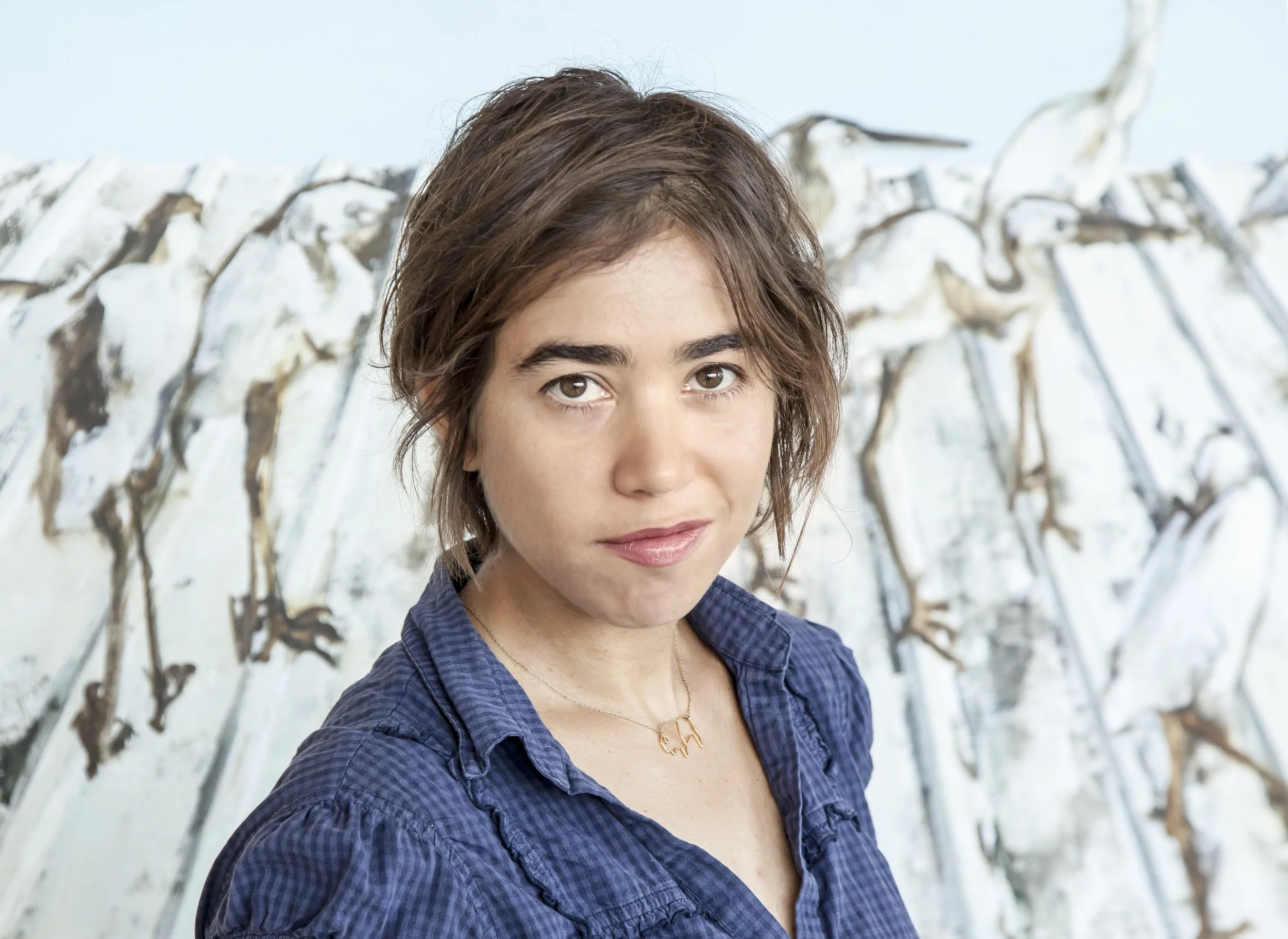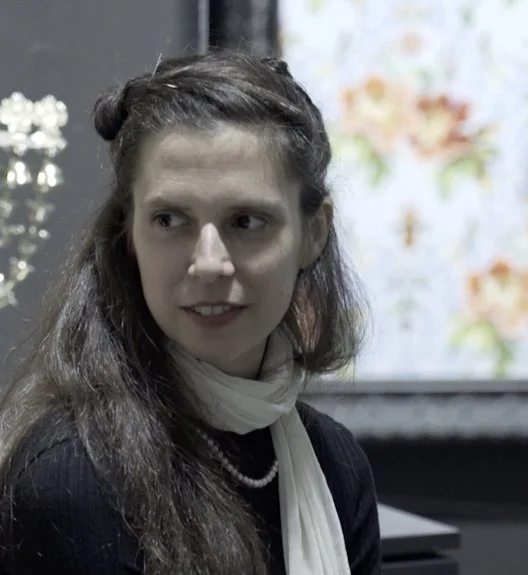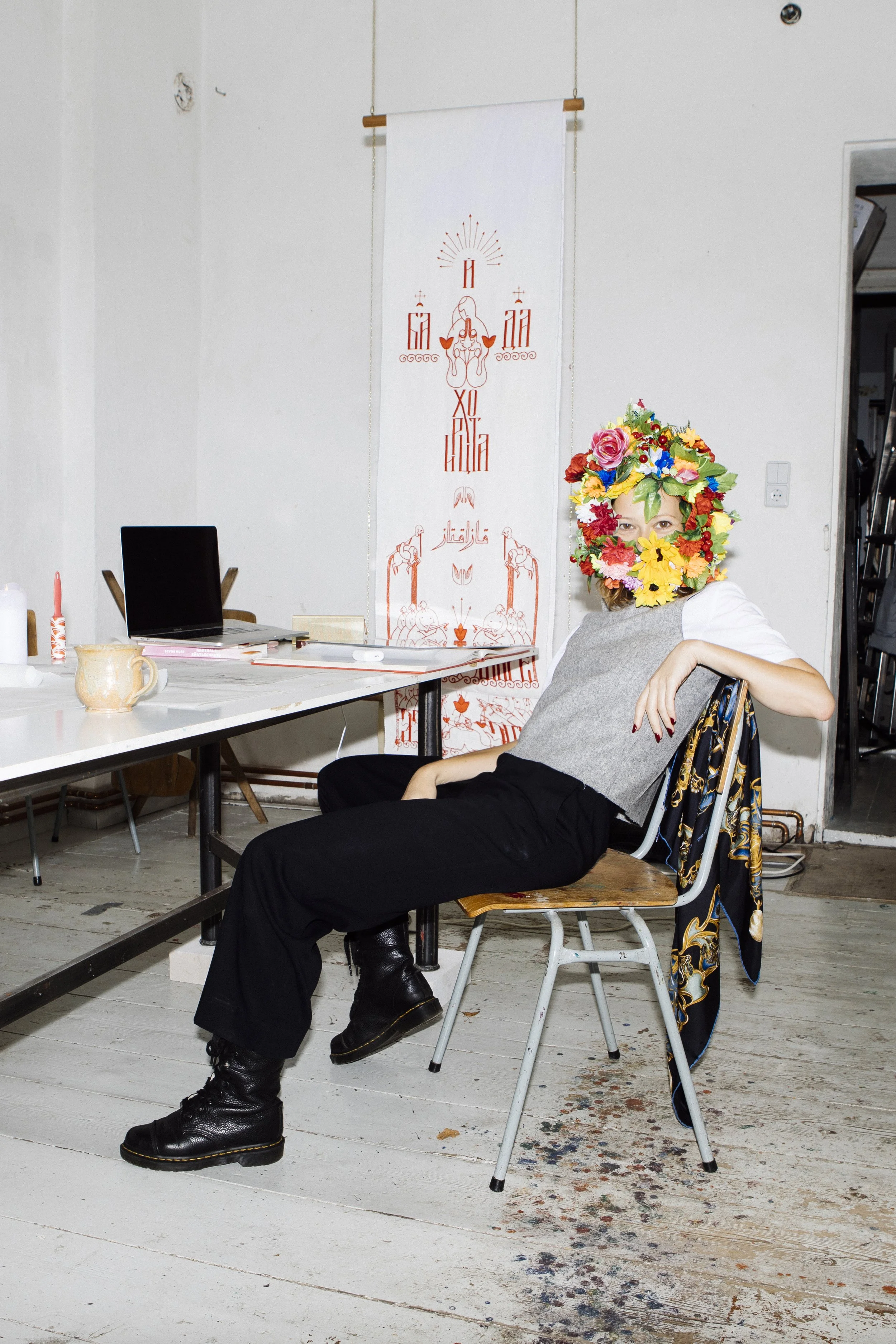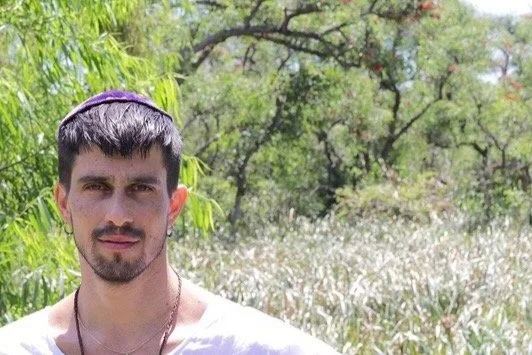ALUMNI

2024 “A Night Journey“
-
![]()
Edna Al-Najar
Edna Al-Najar is a multidisciplinary artist engaging with sculpture, video animation, painting, and photography. Her work delves into themes of resilience, memory, and the interplay of past and future, drawing from collective histories and her experience as a Muslim hijabi woman and a child of the diaspora. Influenced by her parents' experiences with war, trauma and occupation ( from Iraq & Bosnia), Al-Najar's art critiques contemporary injustices while envisioning hopeful futures. She studied fine arts at the State Academy of Fine Arts Stuttgart (graduated January 2024) under professors such as Heba Y. Amin, Ülkü Süngün and Reto Boller. In addition to hosting artistic events such as 2023 at Theater Rampe for the remembrance of the Hanau attack, Edna Al-Najar has exhibited individually or collectively in various notable venues, including the Württembergischer Kunstverein Stuttgart, the Venice Art Biennale, and in Vienna at Muslim*Contemporary 23. She is a recipient of the SHIFT Stipendium from the city of Stuttgart’s Cultural Office.
-
![]()
Yasmine Amal
Yasmine Amal is a self-taught artist based in Berlin. Through her artistic practice she delves into the dynamic relationship between her ancestral ties and diasporic life. For her, painting is thus a profound form of self-exploration as she seeks to fulfill her diverse roles in contemporary society. She explores the meaning of indigenous connection to land, from unearthing wisdom to embracing environmental responsibility.
To Amal, the boundless expanse of the sea symbolizes both freedom and ancestral memory, belonging and return. The artist draws upon the marine world for much of her visual language and color palette, with her pieces often evoking the dynamics of coral reefs, reminiscent of Amazigh symbols.
Amal understands art as a tool aimed at fostering deep transformation and strengthening social cohesion. Through her art, Amal seeks to reverse the effects of individualistic societies and reclaim the narrative of indigenous identities. Central to her work is the desire to facilitate collective learning and healing and create room for cross-cultural dialogue. Her paintings pay homage to the resilience of marginalized communities, creating new spaces for empathy and togetherness.
-
Rüzgâr Buşki
Rüzgâr Buşki, born in Istanbul is a Berlin based artist whose practice focuses on printmaking, video, and performance. They explore themes such as belonging, affect, identity, desire, and tradition. Buşki hacks old media with contemporary topics, reclaiming materials such as wood and stone as exchangeable mediums. Their works have been shown in numerous spaces and institutions, including documenta14 — Parliament of Bodies, DOK Leipzig, Translations Seattle Transgender Film Festival, Schwules Museum, Badischer Kunstverein, Silent Green, Galerie Wedding, and Kunstraum Kreuzberg/Bethanien. They have received several accolades, including the Close-Up Program Fellowship for NonFiction Cinema (2020-2021), the first prize of the Karl Hofer Society Grant (2019), and the Zeliş Deniz Queer Cinema Award at Pink Life Queer Film Festival (2019). Buşki graduated with a Meisterschüler title from the class of Prof. Dr. Hito Steyerl at Berlin University of Arts.
-
![]()
Abie Franklin
Abie Franklin (1995, Jerusalem) graduated from Thelma Yellin High School in Tel Aviv with the highest honors in the visual arts department. After finishing school, he declined the obligatory military service and worked in a children's home instead. Franklin moved to Berlin in 2015, making the city his new home.
His postgraduate diploma in Fine Arts from Kunsthochschule Berlin Weißensee (2016-2022) laid the foundation for his exploration of space, identity, and materiality; assisting Professor Nader Ahriman's class (2020-2022) allowed Franklin to deepen his understanding of colonial legacies within spatial constructs.
In 2022, Franklin co-founded the “Solitudo Residency” in Croatia, fostering artistic collaboration and dialogue. His practice involves looking at archetypes of spatial relations as representations of power dynamics, and narratives of conflict and desire. Within this realm, the materiality of borders is his main focus.
-
![]()
Ali Gharib
Ali Gharib is a German-Lebanese artist. His artworks use a pop-aesthetic mode of expression in multimedia appearances, influenced by his studies of pedagogy (2004-2010) in Cologne and media art (2010-2018) in Karlsruhe as well as by his academic collaboration with Prof. Isaac Julien, Prof. Ingo Günther and Prof. Dr. Siegfried Zielinski. Gharib's work is characterized by a critical approach and a shift towards irony and sarcasm. Thesemanifest themselves in particular in the fictional collective Pipiismus (2009) which operates in close proximity to the tradition of Dada, the Beat Generation and the Fluxus movement.
-
![]()
Ozan Zakariya Keskinkılıç
Ozan Zakariya Keskinkılıç is a Berlin-based political scientist, poet, and interdisciplinary artist. His widely acclaimed book “Muslimaniac: The Career of an Enemy Image” was published by Verbrecher Verlag in 2023. In addition to academic texts, Keskinkılıç writes essays, prose, radio plays, and poetry. In August 2022 his debut collection „Prinzenbad“ was published by Elif Verlag. His poetry is deeply rooted in early Islamic spirituality, queer futurism and cultural-linguistic hybridity. He regularly collaborates with artists from other disciplines to combine literature and poetry with sound, film and theater. His work has been presented in art galleries, various cultural spaces and museums including the Museum of Things and the Museum of European Cultures in Berlin, the Grassi Museum Leipzig, the Literaturpassage in Vienna, and most recently at the Berlin ACUD Gallery. In his art, Keskinkılıç explores themes of race and religion, migration and memory as well as queerness and gender with a subversive, futuristic and often satirical approach. In 2024, he has been nominated for the Clemens-Brentano-Prize and the Dresden Poetry Prize; the jury considers the outstanding features of his writing to include “language that creates open visual and perceptual spaces, sharply contrasted with hard-hitting irony, working with clichés and attributions, humor and a high degree of variability.”
-
![]()
Anna Lublina
Anna Lublina (they/them) plays with invented language, physical theater, puppets, unconventional instruments, ancestral rhythms, and stewardship between humans and the more-than-human world to affirm and celebrate life in the borderlands. Based between Berlin and New York City, Lublina makes performance and community-led projects in theaters, museums, gardens, and anywhere people congregate. As a child of Soviet Jewry, they draw on the practices and aesthetics of Jewish diasporism, Soviet avant-garde/nostalgia, Jewish witchery, and the queer underground to ask questions and propose fantasies for anti-nationalist futures.
Lublina’s performances have been shown in places like St. Ann’s Warehouse, Künstlerhaus Mousonturm, Judson Church, the 14th St Y, The Bloomfield Science Museum, Center for Performance Research, Bread and Puppet Theater, and more. They have been supported by fellowships and residencies such as Akademie Schloss Solitude (upcoming), CEC Artslink Fellowship in Uzbekistan (2024), ID Tanzhaus Frankfurt (2023), the International Jerusalem Fellowship (2022), Helix Fellowship at Yiddishkayt (2020-2022), and Plyspace Fellowship with Ball State University (2021). Lublina has worked as a director and dramaturg for many artists including Julie Weitz, Gry Tingskog, and Andros Zins-Browne. They have an MA in Choreography and Performance from Justus Liebig University Gießen (ATW) and a BA in Art History from Reed College. This year, Lublina is a CEC Artslink Fellow in Bukhara, Uzbekistan, a Mar‘a’yeh LABA Berlin Fellow at Künstlerhaus Bethanien, and a 2024 recipient of the Ottilie-Roederstein award for female* artists. Their newest work “Rhythm in Sediment” will premiere at Produktionshaus NAXOS in March 2025.
-
![]()
Sami Morhayim
Sami Morhayim is a film director, editor, and producer. He graduated from Koç University with a double major in Media & Visual Arts and Psychology. His short film "Susam," which he directed and wrote, has been screened at more than 30 international film festivals. He produced the short film "Ay Bulutta," where he also took on the role of film editor. Additionally, he edited several other short films, including "Flight Mode" which premiered at the Achtung Berlin Film Festival in 2024. Morhayim attended the 2021 Sarajevo Talents as a director and the 4th IKSV Meetings on the Bridge Short Film Development Workshop with his film "Susam." His films and video art explore the absurdities that can occur in daily life. He prefers guerrilla filmmaking, striving to capture naturalness and sincerity. He uses the pseudonym “Ami Mor" for editing duties. Ami Mor is a member of the Film Editors' Society of Turkey.
-
![]()
Maria Margolina
Maria Margolina (1998, Dnipro) is a media and sound artist & cultural worker currently based between Berlin and Munich. In her artistic practice, she primarily focuses on sound, while also incorporating other media such as video, poetry, and objects and photography. Through her work, she explores themes of memory and trauma in a broad sense, engaging with contemporary discourses on memory politics and the state of (late) capitalism, approaching them from political, socio-cultural, and autobiographical perspectives. Her works oscillate between collective, collaborative, participatory, performative, and installation-based approaches. Since 2019, she has been studying at the Academy of Fine Arts in Munich in the classes of Olaf Nicolai, Jan St. Werner, and Hito Steyerl. In addition to her work at various art and music institutions, such as Lothringer 13 Halle, Q-O2, and Haus der Kunst, she has been part of the Munich-based online radio "Radio 80000" since 2020 and is active as a DJ and producer under her pseudonym "Slovva."
-
![]()
Ella Ponizovsky Bergelson
Ella Ponizovsky Bergelson (1984, Moscow) is a visual artist who examines cultural self-definition. Her nomadic anarchist aesthetics, influenced by her hybrid identity, explore displacement and integration through visualization of language. She associates a particular text to a place as an artistic modality, engaging in interventions and site-specific murals within public domains, museums, and galleries.
Language and typography are pivotal cultural components, signifying essence in both content and form. Ponizovsky Bergelson challenges linguistic rigidity by fusing diverse typography systems, fostering visual hybridity. Her works resist easy consumption and are reluctant to be deciphered. In them, the viewer experiences texts as a space of emotion and intent, in which word-images have more than one distinct identity and inherent meaning. Overlapping realities and time, the text takes a new form that reflects upon the simultaneity of the trivial and the life- (or world-) changing events of the present day.
Ponizovsky Bergelson’s notable interventions include; Venice Art Biennale; Jerusalem Biennale; Museum of Islamic and Near Eastern Culture, Israel; Jaffa Museum; Klingspor Museum, Germany; Antique Toy Museum, Mexico; Kindl Brauerei, Berlin; and more.
-
![]()
Benyamin Reich
Benyamin Reich (1976, Bnei Brak) is a multimedia artist whose works deal with identity and gender paradigms. Born into a Hassidic family, Reich left the Orthodox community at age sixteen to dedicate his life to art. He studied at the Musrara School of Photography in Jerusalem, the École Nationale Supérieure des Beaux-Arts in Paris, and the Bezalel Academy of Arts and Design.
Reich's work expands the boundaries between cultures and religions into a universal humanity and beauty. He seeks sparks of holiness in secularized modernity and the human condition. His aesthetic mission explores conflicts and similarities between the Western world and traditional cultures, drawing inspiration from Renaissance humanism and Romanticism. In his portraits, landscapes, and still lifes, Reich combines sensuality and spirituality, the sacred and the profane, nature and civilization. His art has been exhibited in various solo and group exhibitions across Europe.
-
![]()
Alona Rodeh
Alona Rodeh (1979, Israel) is a Berlin-based visual artist, scenographer, and urban practitioner. Rooted in the perception of the nocturnal built environment, her research-driven practices explore material cultures, subcultures, and audiovisual expressions of feelings of safety. She often creates large, immersive virtual and physical environments. Her works are frequently shown in institutional contexts, with large-scale works and solo presentations in places such as Kunstmuseum Gelsenkirchen (2024), Gwangju Biennial (2023), La Casa Encendida Madrid (2021), Kunstpalais Erlangen (2019), Salzburger Kunstverein (2019); Tel Aviv Museum (2013) and others. Rodeh has installed various permanent public artworks in Germany and Israel. Her residencies include, among others, a year-long residency at Künstlerhaus Bethanien, Berlin, and another unique year-long residency at the Berlin Fire Brigade. Rodeh's works are included in numerous public collections, including the LAS Art Foundation, Tel Aviv Museum, and Haaretz Collection. As an extension of her practice, she advocates for Dark Sky International, an NGO focused on restoring nighttime environments and decreasing light pollution.
-
![]()
Dënalisa Shijaku
Dënalisa Shijaku is a Berlin-based abstract painter with Albanian roots. Together with her family, she emigrated to Germany in 1993 and spent her first years in various refugee shelters. She grew up in both East and West Germany. Due to her residency status at the time, she was unable to pursue higher education. Through social media, she managed to establish her career as an artist. Her art serves as a means to capture and express emotions on canvas, and invites the viewer to dive into an endless world of colors, shapes and materials.
Shijaku has exhibited in numerous solo and group exhibitions. She is currently represented in several galleries, including Nuo Gallery (Munich), Lyle Gallery (New York), and Gallery 1888 (Toronto).
2023: “Taboo”
-
![]()
Alma Itzhaky
Dr. Alma Itzhaky is an artist and scholar based in Berlin and Tel-Aviv. Rooted in painting and drawing, her work addresses questions of place and locality, of urban environment and nature, and the relations between humans and nature. Alongside her work as an artist, Itzhaky is a researcher in both political and art philosophy. Her PhD dissertation discusses political action in contemporary art in light of Hannah Arendt’s philosophy of action. She is currently a Minerva Fellow at the Leibniz Center for Literary and Cultural Research, where she explores environmental imaginaries in Palestinian and Israeli art - the engagement between contemporary art and collective perceptions of the local environment and its history.
Itzhaky exhibited numerous group and solo exhibitions, including the Tel Aviv museum, the Hertzelia museum, and Hezi Cohen Gallery. Her residency programs include the NARS foundation residency and the Drawing Center viewing program - both in NYC. She’s won notable prizes including the Rappaport Prize for a Young Artist (2014), and the Osnat Mozes Painting Prize (2012). Itzhaky taught at Shankar College and at the Tel Aviv university.
-
![]()
Hagar Ophir
Hagar Ophir is an artist, costume designer, and performer. Trained as a historian, stage, designer and dancer, her works establish history as a space for action and imagination of possible presents beyond separations of time, nation-states and ideologies. She is currently working on her solo exhibition Bound in the Bundled of The Living (working title) at Soma Art, Berlin (April-May 2023). Her recent works include "Recalling History I," a performative intervention in the production of knowledge (Fundació Tàpies, Barcelona), and "It Is Only Through Your Thoughts That I Can Remember Who I Am” (in collaboration with Hakim Bishara) (Kunsthall 3.14, Bergen). Hagar’s works as an independent artist and a member of Public Movement (2008-2019) were performed and shown worldwide, including at the Jewish Museum Frankfurt am Main, Asian Art Biennial Taipei, Santarcangelo festival.
Working collaboratively in creating knowledge through art and education is part of her practice. In 2020, with five artists and teachers, they founded the Berlin-based collective: mitkollektiv, where she was a co-director of the art and education project Reimagine Jetzt! (funded by the PFCB 2020-2021)
-
![]()
Anisia Affek
Anisia Affek (1989, Ukraine) is a multidisciplinary artist based in Berlin. She holds a BA degree from Shenkar College for Art and Design in Tel-Aviv and a MA degree from Weißensee Academy of Art in Berlin. Affek’s practice concerns issues of cultural erasure and the survival of identity in oppressive environments.
Deeply influenced by her Ukrainian-Russian-Mongolian heritage, Affek works mainly on handmade, large-scale embroidery pieces that push the boundaries of the traditional craft. While using embroidery both as a form of expression and as an object of research, Affek evokes a spiritual space that reaches beyond the Western notions of belonging and the suffocating dichotomy of «us» versus «them.»
Anisia Affek’s artistic practice has won several awards and fellowships, including Stiftung Schöppingen in Germany, (2021), Ateljé Stundars residency in Finland (2021), Young Artist Award from America Israel Cultural Foundation, USA, (2016). Her work has been shown in independent venues and galleries around Ukraine, Israel, Germany, Finland, and Australia. In 2021, she formed a female art space—«A Room of Her Own» in Berlin.
-
![]()
David Krippendorff
David Krippendorff is a US/German interdisciplinary artist and experimental filmmaker. Currently based in Berlin, he grew up in Rome, Italy, and studied art at the University of Fine Arts in Berlin, where he graduated with a Masters degree in 1997. His works, films and videos have been shown internationally, including: the New Museum (New York), ICA (London), Hamburger Kunsthalle (Hamburg), Museum on the Seam (Jerusalem). He has participated in five Biennials (Prague, Poznan, Tel Aviv, Belgrade and Asunción), as well as in many international art and film festivals worldwide. His works are included in many contemporary art collections, museums and institutions.
The son of a Holocaust survivor and the grandchild of practicing Nazis, cultural contradiction and dislocation shaped Krippendorff’s experience early on. His artistic practice inquires into this state of being a “permanent foreigner” and explores resulting questions of home, national and cultural identity, and belonging.
-
![]()
Jordan Lee Schnee
Jordan Lee Schnee / דזשאָרדן לי שניי is a writer, musician, and translator based in Berlin, where he is pursuing a doctorate in comparative literature at the Freie Universität. His PhD project examines the concordant poetics of Kabbalah and OuLiPo texts. Schnee's music projects include Robert Hand, בלינדער שניי, and the Rixdorf Rounders. Schnee has translated many writers from Yiddishland, Europe, and South America and worked closely with the Eloísa Cartonera publishing project in Buenos Aires, Argentina. He is a part of the arts and literature collective Yiddish.Berlin. Recent publications of his own work include Unapprehension / Entfassung (Propeller, 2019/2021) and "טײַטשװערטער / denotations" (Aphaia, 2021).
-
![]()
Kari Rosenfeld
Kari Rosenfeld (b. Houston, TX) is an interdisciplinary artist based in Berlin. Engaging with ontology, political and social affect, religious and mythological narratives, image, and genre, their work affirms the heartbreaks, fantasies, and complications of attachment.
They have degrees in American Studies and Philosophy from the University of Texas at Austin and an MA in Art Praxis from Dutch Art Institute. They co-founded the Cairo Institute of Liberal Arts and Science-Alexandria, were a resident of Spring Sessions (Amman, Jordan), and have had their work recently exhibited at Gasworks, London, Humberstreet Gallery, Hull, and Motto Books, Berlin.
-
![]()
Michaela Kobsa-Mark
Michaela Kobsa-Mark is a U.S.-German documentary filmmaker based in Berlin. Her work focuses on diaspora identity in Germany and takes a participative, humorous and intimate approach. She is interested in examining political issues through the complexity, contrasts and contradictions of peoples' lived experiences. Her work is influenced by ethnographic practices, her run 'n gun background, and her general search for things that are too difficult to be fully grasped. She has worked on a number of documentary and participatory projects in Europe, the U.S. and the Middle East. These projects have been shown in international film festivals, community screenings and in educational settings. She currently studies documentary directing at the Filmakademie Baden-Württemberg.
-
Liad Hussein Kantorowicz
Liad Hussein Kantorowicz is a performance artist, musician, perpetual migrant and master of the margins. Her Performances de-exotify and de-mystify the positions of so-called sexual and political deviants. In them, the body is used as a tool of education, resistance, a platform to display vulnerabilities and as means of transgressing the boundaries of the public spaces while calling for a revolution. Her current research topic is knowledge extraction from the experience of the professionally displaced.
Her work has been shown at the 10th Berlin Biennale, Impulstanz Festival in Vienna, Haus der Kulturen der Welt Berlin, City of Women festival in Ljubljana, CPH:DOX Copenhagen, Arcola Theatre and ICA, London, and in queer and punk bars and live on the street across Palestine, Europe and North America. She’s a graduate of the Solo/Dance/authorship MA program at HZT/UDK Berlin. Her work and world view is informed by years of organizing Palestinian-Israeli direct actions in the West Bank, Palestine, in building radical queer community in Palestine through political actions and cultural events, and decades of organizing for sex workers’ rights across three continents. ‘Nothing to Declare’, the debut album of Liad’s musical project Liadland is set for release this May.
2022: “Broken”
-
![]()
Roey Victoria Heifetz
Roey Victoria Heifetz lives and works in Berlin. Heifetz creates large-scale, textured drawings of people who identify as transgender, often layering portraits of acquaintances with fictional subjects, and exaggerating human features such as skin and muscles. She poses intimate questions in her practice about the body, gender, desire, insecurities, and regrets. Heifetz deals with the mental and physical transitions she is experienced, transitioning from a man’s body to a woman’s body.
Heifetz has already exhibited in numerous international groups and solo exhibitions around the world such as The Leslie Lohman Museum, New York, The Israel Museum, Jerusalem, and Venice Biennale in 2019. in 2018 Heifetz was awarded the Ann and Ari Rosenblatt Award for visual artists and was nominated among the finalist for Marianne Werefkin Award for women artist in Germany.
Heifetz studied at the Bezalel Academy for Arts and Design in Jerusalem (BFA, MFA) and at the School of the Museum of Fine Art in Boston, USA.
-
![]()
Perel
Perel is an interdisciplinary artist whose work is centered on disability and queerness as they relate to care, consent, sexuality, and personal and historic trauma. Utilizing choreography to examine power exchange between the artist and audience, “Perel is a master at timing, of tension, relief, and intimacy while creating a space of learning and unlearning.” (Victoria DeJaco, Spike Magazine).
Their work includes performance, installation, criticism and curatorial projects. They often use collaboration as a platform for the exchange of disciplines, working methods and discourses with other choreographers, composers and visual artists. Perel asks, “How do we move across space and time with respect to our collected histories?” Their work has been shown for more than a decade at numerous galleries, theaters and performance spaces in the U.S. and abroad. Perel tours and teaches internationally, as a university lecturer and mentor to emerging disabled artists at organizations in New York and Berlin.
-
![]()
Alex Stolze
Alex Stolze is an EastBerlin-born violinist and producer, with a well-deserved reputation, both as composer and collaborator. Shifting seamlessly between stark modern classical works and fiercely intelligent electronica he manages to craft his own consistent sound throughout. Middle-Eastern scales, plaid on his 5-string violin, create a beguiling tonal landscape. Complex polyrhythms and unusual time signatures are turned into addictive, danceable beats, while he is recording his violin live on stage to create a multilayered string sound on his looper. He has toured widely across Europe. Past concerts include e.g. Elbphilharmonie (Hamburg), Cirque Electrique (Paris), Union Chapel (London), Volksbühne (Berlin) His emergence as a solo artist, collaborator and as initiator of music label collective Nonostar have opened up a range of new cooperations. The Nonostar label , on which artists like Anne Müller, Ben Osborn, Qrauer and Field Kit have released so far, is based at his remote creative workspace on the German-Polish border. The self renovated ruins recently developed into an international artist village that connects music, art, poetry, dance and circus.
-
![]()
Ryan Kopstick
Ryan (Yebu-Tonu) is a 3D and new media artist from Toronto, Canada. Originally starting his career-path in brain research, Ryan graduated from the University of Guelph with a major in psychology and minor in neuroscience. In 2017 he withdrew from graduate school in neuroscience, as his academic interests turned more towards a growing desire to experiment with subjectivity through art. He has exhibited globally across digital art-focused exhibitions including Blue \x80 (2018), Fu:bar (2019), Signal Flo (2019), and A Strange World (2022). His works are inspired by his interest in psychoanalysis and trauma, both as a tool in aesthetic expression, and as a history married to modern art. He currently resides in Berlin, Germany, where he facilitates an online Freud reading group, and is working on a visual mini-series inspired by Remedios Varo.
-
![]()
Gal Ovadia Naor
Gal Ovadia Naor Magenn is a Berlin-based Sign-Language interpreter, performer, choreographer, theater maker, mind-body researcher, and founder of The progressive wave GbR. Gal was born in Israel in 1986. He graduated from the theater department of Thelma-Yellin High School of Arts in 2004. In 2010, Gal graduated from a four-year performance studies program at the School of Visual Theater in Jerusalem. In 2011, he received his diploma in Israeli-Sign-Language-Interpretation at Bar-Ilan University in Ramat-Gan, Israel. Later that year, Gal moved to Berlin. in 2014, he founded The progressive wave GbR with choreographer Matan Zamir. Their multidisciplinary and inclusive approach interfaces dance and visual art with sociopolitical content and consciousness studies. Since 2004, Gal has been studying Jewish secret mysticism, a.k.a Kabbalah (also means “Acceptance” in Hebrew) in a unifying prism, decoding the ancient wisdom into an up-to-date comprehensive practice to (re)claim religious ideas to the queer and secular communities.
-
![]()
Ella Ponizovsky Bergelson
Ella is a multilingual visual artist who was born in Moscow, immigrated to Israel in 1991 and since 2016 lives and works in Berlin. Her own hybrid identity drives her to inspect cultural self-definition in individuals and in communities. In her work she explores and contemplates manifestations of migration and integration processes through visualisation of language. She studied in Bezalel Academy of Arts Jerusalem and in the School of Visual Arts NY City. In 2022 she represented the Yiddish culture in the frame of the Yiddishland Pavilion in the Venice art biennale. Ella believes that connecting a particular text to a place is a form of art. She creates interventions in public space and site-specific murals in public locations such as Klingspor Museum Offenbach am Main, the Jerusalem Biennale, Antique Toy Museum Mexico City, ZK/U Berlin and Kindl Brauerei Berlin. Paper installations were shown in Jaffa Museum, Museum of Islamic and Near Eastern Culture Be'er Sheva, Root Division gallery San Francisco, Literaturhaus Berlin, Mazeh 9 Gallery Tel Aviv and more. Work is included in the collection of Klingspor Museum Offenbach am Main. Reviews and interviews have been published in numerous media channels, including the Federal Agency for Civic Education, Germany, Der Tagesspiegel, the Jüdische Allgemeine, In Geveb, Nashim: A Journal of Jewish Women’s Studies and Gender Issues - Indiana University Press, Asymptote Journal and others.
-
![]()
Wal Solon
Wal Solon is an interdisciplinary artist working across filmmaking, visual arts, literature and music. Wal earned a BA in Social Sciences at the University of São Paulo, with study abroad semesters in Paris and Cologne. In 2014, he enrolled at the Academy of Media Arts Cologne, on a DAAD scholarship, spending a semester at Art Center in Pasadena, California. In 2021, he went back to Brazil to record his first album, Foundation, singing songs about family taboos around HIV, survival, trauma and suicide. The project developed from a residency at Pivô, Sao Paulo, supported by Goethe-Institut and Kunststiftung NRW. Wal's films and installations have been shown at Goethe Institut Beijing, Art Sonje Center Seoul, the Thessaloniki Biennale, Oberhausen Short Film Festival and Kassel DokFest. His current project is a satirical short-film exposing the rituals of corruption and reparation between a former Nazi armament manufacturer and its new clients, Israel among them.
-
![]()
Tomer Dotan-Dreyfus
Tomer Dotan-Dreyfus is an Israeli-born author, poet and translator. Hebrew is his native language, yet he has lived in Berlin for over a decade and writes mainly in German. He holds a BA and MA degrees from the Free University of Berlin, both in Comparative Literature and Philosophy, his MA-thesis presented a research into the singularities of the letter O and will soon be published in the coming summer as a book of essays. His recent translations from German to Hebrew include Walter Benjamin and Mascha Kaleko. in recent years he has published poetry in literary journals. Dotan-Dreyfus received a working stipend of the Berliner Senate for German-language writers in 2020 for his first novel Birobidzhan, a post-apocalyptic story set in a yiddish speaking town in Siberia, the novel will be published by Voland & Quist Verlag in 2023. He received a 2022 stipend of the German writers association (VG Wort) for his second novel. Since the beginning of the pandemic, Tomer is leading a seminar online, which researches the language used in apocalyptic literature.
2021: “Chose-n”
-
![]()
Julia Bosson
Julia is a writer originally from Ojai, California. Her work has appeared in publications such as BOMB, VICE, Guernica, and the Believer, among others. She received a BA and MFA from Columbia University in creative writing and has taught at the Cooper Union, Columbia University, and Baruch College. The recipient of a Fulbright Grant, she has been awarded fellowships and residencies from the Wassaic Project, Vermont Studio Center, Monson Arts, Woodstock Byrdcliffe Guild, and the Catwalk Institute. She currently resides in Berlin, Germany, where she is at work on a novel about the life and journalism of Joseph Roth.
-
![]()
Noa Heyne
Noa is a Berlin-based multidisciplinary artist. Heyne works in sculpture, performance, and animation; she creates installations that emphasize the physical involvement of the viewers and are influenced by marionette theater and architecture. Heyne studied painting and comparative literature in Jerusalem, and received her MFA in sculpture from the Maryland Institute College of Art (2017), where she also held a position as an adjunct professor in 2018. She is the recipient of several awards and fellowships, among them the ZK/U residency, Berlin (2019); Culture Zone residency, Wroclaw, Poland (2020); Sculpture Space, Utica, NY (2021).
-
![]()
Rachel Kohn
Rachel was born in Prague and grew up in Munich, where she studied at the Academy of Fine Arts. Since 1993 she has been living in Berlin as a freelance sculptor and has been supported by the Künstlerförderung Berlin and the Stiftung Zurückgeben. In 2009 she constructed a memorial for murdered children of forced labourers in Otterndorf, Lower Saxony and in 2016 a 12 meter high installation in the Jewish community hall in Nuremberg. A lot of her Judaica has been given to german politicians as gifts from Jewish organisations. Rachel has been on the board of the Frauenmuseum Berlin since 2007 and member of BBK Berlin, Verein der Berliner Künstlerinnen 1867 and sculpture network. In 2020 she co-founded the activist group fair share for women artists.
-
![]()
Tomer Zirkilevich
Tomer is a Berlin-based Israeli choreographer, director, performer and teacher. After graduating from School of Dance Arts at the Kibbutzim College, Tel-Aviv, he moved to Germany in 2013, where he founded the Tomer Zirkilevich Company. He is actively involved in the German independent dance scene, creating and producing most of his works between Berlin and Munich. His works have been shown in various festivals and venues around Europe including: My David & SODOM; Infidelity: A love story; Like Father Likes Son (part 2); Auf Wiedersehn and more. His video dance Sachliche Romanze won several prizes in festivals around the world. Tomer works in the fields of physical theater, screen-stage performance and video dance. His pieces deal with conflicts of values and social norms.
-
![]()
Gur Liraz
Gur is an Israeli Jazz guitar player and composer based in Berlin. Gur majored in Jazz at the prestigious Thelma Yellin High School, before taking up the classical guitar for his studies in Jerusalem. In 2013 after studying with Jazz guitar legend Peter Bernstein in New York, Gur moved to Berlin and soon became involved in its rapidly evolving Jazz scene. He performs and records regularly with some of the scene’s most promising musicians, as well as in his hometown of Tel-Aviv and around Europe. He also studied Literary studies at the JFK institute at the Freie Universität Berlin.
-
![]()
Anna Mirkin
Anna was born in Moscow and immigrated to Israel in 1992, living and working in Berlin since 2018. She merges different disciplines and mediums in her practice combining; painting, drawing, textile, new media, installations, and performance, with participatory and community-based projects. Her work explores collective sub consciousness and individual self-identity, as they appear in cultural structures and everyday situations. Her solo exhibitions include: ‘Right of Passage’ in Haifa Museum of Art, IL, 2012. ‘Wasteland’ representing the Israeli embassy in Art Beijing art Fair, CHN, 2013. ‘Layer No 2’ Beeri Gallery, accompanied by an exhibition catalogue, IL, 2017. And ‘Layer No 5’ at ‘Ha Hader’ project space, TLV, IL, 2019.
-
![]()
Rachel Libeskind
Rachel is a multidisciplinary artist whose research-based practice examines the construction of history and the enduring power of images. Working across collage, installation, video and performance, Libeskind appropriates and recontextualizes images in order to disrupt imposed boundaries – between the personal and public, ancient and contemporary, societal and cultural – and reveal unexpected parallels. Libeskind has presented solo exhibitions, installations and performances at Center for Jewish History, New York; Watermill Center, Long Island; Pioneer Works, Brooklyn; Bombay Beach Biennale; Mana Contemporary, Miami. She holds a B.A. with honors from Harvard University.
-
![]()
Zero Pilnik
Zero is a gender-bending, accordion-playing storyteller from São Paulo, Brazil. As an actor and writer, Zero aims to provoke audiences through performances that subvert the norm. They graduated from California Institute of the Arts with a BFA in acting and creative writing. Currently in development are "Brutes", a dystopic queer Spaghetti Western TV series, among other projects for stage and screen. You can also catch them performing regularly in Drag King stages throughout Berlin as Mojo, the Sword Swallower of Switzerland. Zero’s “27 Club – a quarter-life crisis rock ‘n’ roll funeral” was performed twice to a full house in early December at Framed in Friedrichshain.



